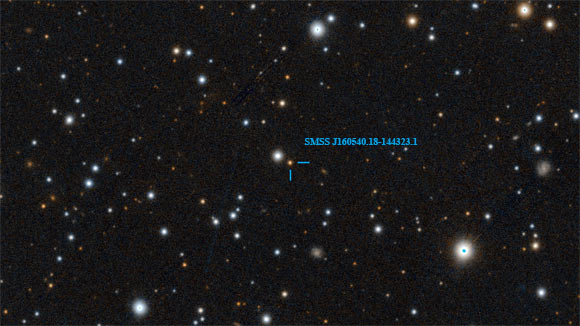Astronomers Discover Milky Way’s Most Iron-Poor Star | Astronomy – Sci-News.com
SMSS J160540.18-144323.1, an ultra-metal-poor red giant star located in the halo of the Milky Way, on the other side of the Galaxy about 35,000 light-years from Earth, contains a record-low amount of iron, according to a new study.

This image shows the ultra-metal-poor star SMSS J160540.18-144323.1. Image credit: Centre de Données astronomiques de Strasbourg / SIMBAD / PanSTARRS .
The very first stars in the Universe are thought to have consisted of only hydrogen and helium, along with traces of lithium.
These elements were created in the immediate aftermath of the Big Bang, while all heavier elements have emerged from the heat and pressure of cataclysmic supernovae.
Stars like the Sun that are rich in heavy elements therefore contain material from many generations of stars exploding as supernovae.
As none of the first stars have yet been found, their properties remain hypothetical.
They were long expected to have been incredibly massive, perhaps hundreds of times more massive than the Sun, and to have exploded in incredibly energetic supernovae known as hypernovae.
The discovery of SMSS J160540.18-144323.1, although itself not one of the first stars, adds a powerful bit of evidence.
Dr. Thomas Nordlander from the Australian National University node of the ARC Centre of Excellence for All Sky Astrophysics in 3 Dimensions (ASTRO 3D) and colleagues located this star using the SkyMapper Telescope at the Siding Spring Observatory.
Spectroscopic analysis indicated that the star had an iron content of just one part per 50 billion.
“That’s like one drop of water in an Olympic swimming pool,” Dr. Nordlander said.
“This incredibly anemic star, which likely formed just a few hundred million years after the Big Bang, has iron levels 1.5 million times lower than that of the Sun.”
Dr. Nordlander and co-authors suggest that SMSS J160540.18-144323.1 was formed after one of the first stars exploded.
That exploding star is found to have been rather unimpressive, just 10 times more massive than the Sun, and to have exploded only feebly so that most of the heavy elements created in the supernova fell back into the remnant neutron star left behind.
Only a small amount of newly-forged iron escaped the remnant’s gravitational pull and went on, in concert with far larger amounts of lighter elements, to form a new star — one of the very first second generation stars, that has now been discovered.
“It was unlikely that any true first stars have survived to the present day,” said Professor Martin Asplund, a chief investigator of ASTRO 3D at the Australian National University.
“The good news is that we can study the first stars through their children — the stars that came after them like the one we’ve discovered.”
The findings appear in the Monthly Notices of the Royal Astronomical Society: Letters (arXiv.org preprint).
_____
T. Nordlander et al. 2019. The lowest detected stellar Fe abundance: the halo star SMSS J160540.18-144323.1. MNRASL 488 (1): L109-L113; doi: 10.1093/mnrasl/slz109





